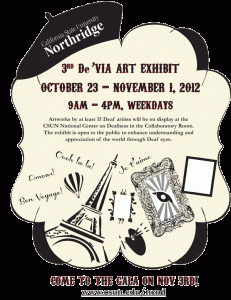CSUN’s De’VIA Art Exhibit Explores the Art World Through Deaf Eyes
Hoping to enhance understanding and appreciation of the world through the eyes of the deaf, California State University, Northridge is hosting it’s third De’Via Art Exhibit, which features work by deaf artists.
 The exhibit, sponsored by CSUN’s National Center on Deafness, located in the NCOD near the center of the campus at 18111 Nordhoff St. in Northridge. The exhibit runs through Nov. 1 from 9 a.m. to 4 p.m., Monday through Friday, and is free and open to the public.
The exhibit, sponsored by CSUN’s National Center on Deafness, located in the NCOD near the center of the campus at 18111 Nordhoff St. in Northridge. The exhibit runs through Nov. 1 from 9 a.m. to 4 p.m., Monday through Friday, and is free and open to the public.
The show spotlights deaf artists and their perceptions based on their unique experiences.
“The De’VIA program is to acquaint and enlighten everyone about the deaf artists’ experiences and feelings regarding life,” said Roz Rosen director of the National Center on Deafness.
De’VIA is created, Rosen explained, when an artist intends to express their deaf experience through visual art. It uses formal art elements with the intention of expressing innate cultural or physical deaf experience. These experiences may include deaf metaphors, deaf perspectives and deaf insight in relationship with the environment (both the natural world and deaf cultural environment), spiritual and everyday life.
De’VIA was created when eight deaf artists gathered for a four-day workshop before the 1989 Deaf Way arts festival at Gallaudet University. These artists produced a manifesto defining deaf culture art, which they called De’VIA, short for Deaf View/Image Art.
The National Center on Deafness has placed California State University, Northridge at the forefront internationally in the provision of services to people who are deaf and have other disabilities. Specifically, National Center of Deafness has been honored for service to the campus and community, as well as for its specialized projects and materials used across the nation.
The National Center on Deafness’ nationally recognized support system of note takers, tutors and interpreters allows CSUN’s approximately 250 deaf and hard-of-hearing students to take full part in university life.
CSUN’s population of deaf and hard-of-hearing students is one of the largest at any mainstream university in the United States. The university was among the first to offer services to mainstream these students, beginning 50 years ago.

 experience
experience